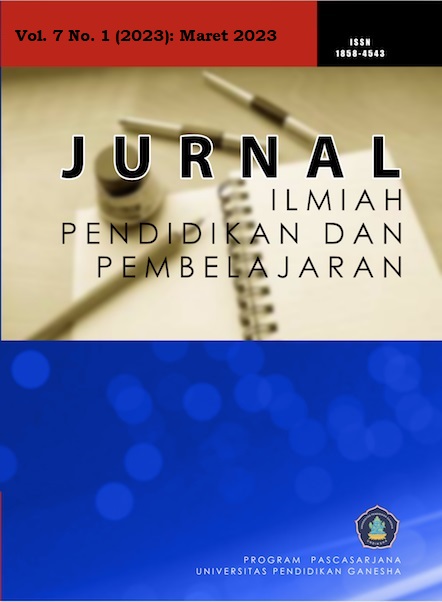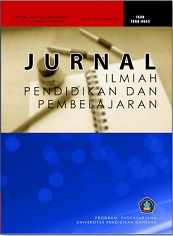Greene and Petty's Criteria: The Quality of Grade II Students' Theme 4 Books
DOI:
https://doi.org/10.23887/jipp.v7i1.57740Keywords:
Quality Analysis, Student Books, Elementary School, Greene and PettyAbstract
A good knowledge book is a novel that can accommodate students in solving environmental cases, does not bring wrong thoughts, and can be presented to scientific laws. This book is very useful for teachers as a learning resource to improve student learning outcomes. Through the evaluation of Greene and Petty theory textbooks, this study intends to evaluate the caliber of grade II students' books on subject 4, Clean and Healthy Living, in primary schools. Researchers employed qualitative research methodologies and qualitative research analysis approaches in this study. According to Greene and Petty, the study used ten criteria for high-quality books. The data source used is the book of grade II student themes 4 of the 2013 curriculum. Data were collected during this study using documentation and observation techniques. The strategies used in this work for interactive model data analysis include data reduction, data storage, and data validation. The method used to collect data is sheet analysis, consisting of a set of data collection criteria and tools. Based on the study's results, grade II student books theme 4 of the 2013 curriculum scored 93,5% with high-quality categories.
References
Amelia, R., Priatmoko, S., & Sugiri, W. A. (2021). Kesulitan Guru Sekolah Dasar Dalam Mengembangkan Desain Pembelajaran Online Di Masa Pandemi Covid-19. Elementary School Education Journal, 5(1), 198–209. https://doi.org/10.30651/else.v5i2.8652.
Apriyani, L. A., & Robiasih, R. H. (2019). Eight Grade Text Book Evaluation By Cunningsworth’s Theory. Journal of English Language and Pedagogy, 2(2), 94–103. https://doi.org/10.36597/jelp.v2i2.4865.
Aziz, A. (2011). Curriculum Development in Indonesian Education. Curriculum Development in Indonesian Education, 3(2). https://doi.org/10.18860/jt.v0i0.1312.
Bagon, Š., Gačnik, M., & Starčič, A. I. (2018). Information communication technology use among students in inclusive classrooms. International Journal of Emerging Technologies in Learning, 13(6), 56–72. https://doi.org/10.3991/ijet.v13i06.8051.
Dekawati, I. (2020). The Principal’s Leadership as the Effort To Build Students’ Character. International Journal of Educational Management and Innovation, 1(2), 109. https://doi.org/10.12928/ijemi.v1i2.1631.
Desstya, A., Yanti, F. A., & Saputro, A. D. (2020). Miskonsepsi Guru Sekolah Dasar Pada Konsep Bunyi. Journal Of Basic Education, 4, 115–125. https://doi.org/10.24269/ajbe.v4i2.2342.
Dewantara, K. A. ., Artini, L. ., & Wahyuni, L. G. . (2022). Reading Related Activities in English Textbook and How the Texts are Exploited in the Classroom. Journal of Education Research and Evaluation, 6(3). https://doi.org/10.23887/jere.v6i3.48583.
Dharma, Prasetya, Y., Aristo, T., & Verawanto, J. (2018). An Analysis of English Textbook Relevance to the 2013 English Curriculum. Journal of English Educational Study, 1(1), 24–33. https://doi.org/10.31932/jees.v1i1.277.
Fatmawati, Y., Purnomo, M. E., & Suhendi, D. (2022). Improving Student Learning Outcomes Through Innovative Textbooks In Writing Persuasive Texts. JPI (Jurnal Pendidikan Indonesia), 11(1), 172–182. https://doi.org/10.23887/jpi-undiksha.v11i1.23413.
Gaitas, S., & Alves Martins, M. (2017). Teacher perceived difficulty in implementing differentiated instructional strategies in primary school. International Journal of Inclusive Education, 21(5), 544–556. https://doi.org/10.1080/13603116.2016.1223180.
Hakim, M. L., Uswatun, D. A., & Nurasiah, I. (2020). Analisis Unsur Intrinsik Puisi Pada Buku Siswa Bahasa Indonesia Dikelas 4 Sekolah Dasar. Jurnal Ilmu Pendidikan Dasar, 3, 326–335. https://doi.org/10.31100/dikdas.v3i2.704.
Hutagalung, B., & Purbani, W. (2021). The Ability Of Digital Literacy For Elementary School Teachers. JPI (Jurnal Pendidikan Indonesia), 10(4), 710–721. https://doi.org/10.23887/jpi-undiksha.v10i4.32938.
Khoirunnisa, R., Aldina, R. A., Harlinah, & Yanti, P. G. (2020). Analisis Kesesuaian Materi Bahasa Indonesia Pada Buku Siswa Kelas III Semester 1 Revisi 2018 di Sekolah Dasar Dengan Kurikulum 2013. Spektrum Penelitian Pendidikan Dasar, 1(1), 1–8. http://repository.unpas.ac.id/49717/.
Knauer, H. A., Jakiela, P., Ozier, O., Aboud, F., & Fernald, L. C. H. (2020). Enhancing young children’s language acquisition through parent–child book-sharing: A randomized trial in rural Kenya. Early Childhood Research Quarterly, 50, 179–190. https://doi.org/10.1016/j.ecresq.2019.01.002
Kurniawan, B. G., & Marzuki. (2022). The Guidance Of Multicultural Citizenship Character On Pondok Pesantren. JPI (Jurnal Pendidikan Indonesia), 11(2), 192–200. http://repo.unida.gontor.ac.id/1974/.
Limiansih, K. (2016). Analisis Buku: Apakah Kegiatan di Buku Siswa Kelas IV SD Kurikulum 2013 Telah Mendukung Pembelajaran IPA Dengan Pendekatan Saintifik? Prosiding Seminar Nasional Inovasi Pendidikan Inovasi Pembelajaran Berbasis Karakter Dalam Menghadapi Masyarakat Ekonomi ASEAN FKIP UNS (115–137), 115–137. https://jurnal.fkip.uns.ac.id/index.php/snip/article/download/8928/6490.
Machali, I. (2014). Kebijakan Perubahan Kurikulum 2013 dalam Menyongsong Indonesia Emas Tahun 2045. Jurnal Pendidikan Islam, 3(1), 71–94. https://doi.org/10.14421/jpi.2014.31.71-94.
Mahayanti, N. W. S., Artini, L. P., & Jannah, N. (2017). the Effect of Big Book As Media on Students’ Reading Comprehension At Fifth Grade of Elementary School in Sd Laboratorium Undiksha Singaraja. International Journal of Language and Literature, 1(3), 2549–4287. https://doi.org/10.23887/ijll.v1i3.12544.
Malik, M. S. (2020). Analisis HOTS, 4C, Literasi, dan Pendidikan Karakter Dalam Seni Budaya dan Prakarya MI/SD Kurikulum 2013. Elementary Islamic Teacher Journal, 8, 59–82. https://scholar.archive.org/work/wukcmcpmpffd7aabx7csylao2q/access/wayback/https://journal.iainkudus.ac.id/index.php/elementary/article/download/6727/pdf.
Mulyasa. (2014). Pengembangan dan Implementasi Kurikulum 2013: Perubahan dan Pengembangan Kurikulum 2013 Merupakan Persoalan Penting dan Geting (A. S. Wardan (ed.); 4th ed.). Remaja Rosdakarya.
Noble, C., Sala, G., Peter, M., Lingwood, J., Rowland, C., Gobet, F., & Pine, J. (2019). The Impact Of Shared Book Reading On Children’s Language Skills: A Meta-Analysis. Educational Research Review, 28, 1–10. https://doi.org/10.1016/j.edurev.2019.100290.
Onas, F., Nurhayati, & Mukmin, S. (2022). The Lecturer’s And College Students’ Need Toward Schoology-Based Student Worksheet. JPI (Jurnal Pendidikan Indonesia), 11(2), 183–191. https://repository.unsri.ac.id/90600/.
Pahenra, P., Hermanto, H., Amalia, W. S., & ... (2022). Establishment Of Childhood’s Discipline Characters In a Clean And Healthy Life Behavior In The Pandemic Covid-19. JPI (Jurnal Pendidikan Indonesia), 11(2), 210–218. https://doi.org/10.23887/jpiundiksha.v11i2.34667.
Priatmoko, S. (2018). Memperkuat Eksistensi Pendidikan Islam Di Era 4.0. TA’LIM: Jurnal Studi Pendidikan Islam, 1(2), 221–239. https://doi.org/10.52166/talim.v1i2.948.
Priatmoko, S., Sugiri, W. A., & Wibowo, A. M. (2022). Developing Supplementary Book for Constructing Tests With Minimum Competency Assessment For Elementary Schools Teachers. Al Ibtida: Jurnal Pendidikan Guru MI, 9, 1–18. https://doi.org/10.24235/al.ibtida.snj.v9i1.9451.
Purnanto, A. W., & Mustadi, A. (2016). Analisis Kelayakan Bahasa Dalam Buku Teks Tema 1 Kelas I Sekolah Dasar Kurikulum 2013. Profesi Pendidikan Dasar, 3(2), 102–111. https://doi.org/10.23917/ppd.v3i2.2773.
Puspito, W. G., Sutopo, A., & Desstya, A. (2022). Analisis Kesesuaian Buku Tematik Sekolah Dasar Dengan Kurikulum 2013. Jurnal Basicedu, 6, 354–363. https://doi.org/10.31004/basicedu.v6i1.1911.
Rahman, A., Munandar, S. A., Fitriani, A., Karlina, Y., & Yumriani. (2022). Pengertian Pendidikan, Ilmu Pendidikan dan Unsur-Unsur Pendidikan. Al Urwatul Wutsqa: Kajian Pendidikan Islam, 2(1), 1–8. https://journal.unismuh.ac.id/index.php/alurwatul/article/view/7757.
Rahmawati, F. P., & Rusdiyani, E. (2020). Analisis Kelayakan Buku Penilaian (Bupena) Disekolah Dasar. Profesi Pendidikan Dasar, 1(1), 77–92. https://doi.org/10.23917/ppd.v1i1.10996.
Rokhim, D. A., Widarti, H. R., & Fajaroh, F. (2020). Pengembangan Bahan Belajar Flipbook pada Materi Redoks dan Elektrokimia Berbasis Pendekatan STEM-PjBL Berbantuan Video Pembelajaran. Kwangsan: Jurnal Teknologi Pendidikan, 8(2), 234–250. https://doi.org/http://doi.org/10.31800/jtp.kw.v8n2.p234--250 PENGEMBANGAN.
Rukin. (2019). Metodologi Penelitian Kualitatif. In Yayasan Ahmar Cendekia Indonesia.
Sopiansyah, D., Masruroh, S., Zaqiah, Q. Y., & Erihadiana, M. (2022). Konsep dan Implementasi Kurikulum MBKM (Merdeka Belajar Kampus Merdeka). Reslaj: Religion Education Social Laa Roiba Journal, 4(1), 34–41. https://doi.org/10.47467/reslaj.v4i1.458.
Soryani, S. (2015). Penanaman Sikap Toleransi Di Kelas V Sd Negeri Siyono Iii Kecamatan Playen Kabupaten Gunungkidul. Basic Education, 4(16), 1–17. https://journal.student.uny.ac.id/index.php/pgsd/article/view/1197.
Supriadi. (2015). Pemanfaatan Sumber Belajar Dalam Proses Pembelajaran. Journal Lantanida, 3, 127–139. https://doi.org/10.22373/lj.v3i2.1654.
Suryana, C., Nurwahidah, I., & Hernawan, A. H. (2022). Komparasi Implementasi Kurikulum 2013 dan Kurikulum Merdeka di Sekolah Dasar. Jurnal Basicedu, 6, 5877–5889. https://jbasic.org/index.php/basicedu/article/view/3149.
Susilawati, M. (2022). An Evaluation Of English Textbook Entitled “Kiddie 1” For Kindergarten In English Study Centre. International Undergraduate Conference on English Education, 1(1), 163–168. https://doi.org/10.12928/iucee2022.v1i1,%20March.9021.
Syabrina, M., & Sulistyowati. (2021). Pengembangan Buku Ajar Tematik Sekolah Dasar Berbasis Karakter Religius. Madrasah: Jurnal Pendidikan Dan Pembelajaran Dasar, 14(1), 29–40. https://doi.org/10.18860/mad.v14i1.12176.
Syahputri, N. R., & Murdiono, M. (2022). The Impact Of Digital-Based Mind Map On Creative Thinking Skills In Civic Education Learning. JPI (Jurnal Pendidikan Indonesia), 11(1), 78–85. https://doi.org/10.23887/jpi-undiksha.v11i1.34154.
Syarifatunnujum, W. (2022). Analisis Buku Ajar Tematik Tema Selalu Berhemat Energi Kurikulum 2013 untuk SD / MI Kelas IV. Jurnal Pendidikan Tambusai, 6, 3317–3328. https://www.jptam.org/index.php/jptam/article/view/3399.
Tambak, S., Hamzah, H., Sukenti, D., & Sabdin, M. (2021). Internalization of Islamic Values in Developing Students’ Actual Morals. JPI (Jurnal Pendidikan Indonesia), 10(4), 697–709. https://doi.org/10.23887/jpi-undiksha.v10i4.30328.
Tarigan, H. G., & Tarigan, D. (2009). Telaah Buku Teks Bahasa Indonesia. Angkasa.
Tusriyanto, Nadiroh, Japar, Wahyudi, A., Aminudin, K., & Widayati, E. (2019). Improved of critical thinking skills and social skills for students through inquiry learning (Guided enquiry) based literacy on the subject of social sciences in class v. Opcion, 35(Special Issue 20), 2989–2921. https://dialnet.unirioja.es/descarga/articulo/8355741.pdf.
Widiana, I. W., & Jampel, I. N. (2016). Improving Students’ Creative Thinking And Achievement Through The Implementation Of Multiple Intelligence Approach with Mind Mapping. International Journal of Evaluation and Research in Education (IJERE), 5(3), 246–254. https://doi.org/10.11591/ijere.v5i3.4546.
Widiana, I. W., Parera, N. P. G., & Yuda Sukmana, A. I. W. I. (2019). Media Permainan Ular Tangga Untuk Meningkatkan Hasil Belajar Siswa Kelas IV Pada Kompetensi Pengetahuan IPA. Journal of Education Technology, 3(4), 315–322. https://doi.org/10.23887/jet.v3i4.22556.
Yusuf, B., Walters, L. M., & Sailin, S. N. (2020). Restructuring Educational Institutions for Growth in The Fourth Industrial Revolution (4IR): A Systematic Review. International Journal of Emerging Technologies in Learning, 15(3), 93–109. https://doi.org/10.3991/ijet.v15i03.11849.
Downloads
Published
How to Cite
Issue
Section
License
Copyright (c) 2023 Dewa Duta Mandala, Sukartono

This work is licensed under a Creative Commons Attribution-ShareAlike 4.0 International License.
Authors who publish with the Jurnal Ilmiah Pendidikan dan Pembelajaran (JIPP) agree to the following terms:
- Authors retain copyright and grant the journal the right of first publication with the work simultaneously licensed under a Creative Commons Attribution License (CC BY-SA 4.0) that allows others to share the work with an acknowledgment of the work's authorship and initial publication in this journal.
- Authors are able to enter into separate, additional contractual arrangements for the non-exclusive distribution of the journal's published version of the work (e.g., post it to an institutional repository or publish it in a book), with an acknowledgment of its initial publication in this journal.
- Authors are permitted and encouraged to post their work online (e.g., in institutional repositories or on their website) prior to and during the submission process, as it can lead to productive exchanges, as well as earlier and greater citation of published work. (See The Effect of Open Access)










